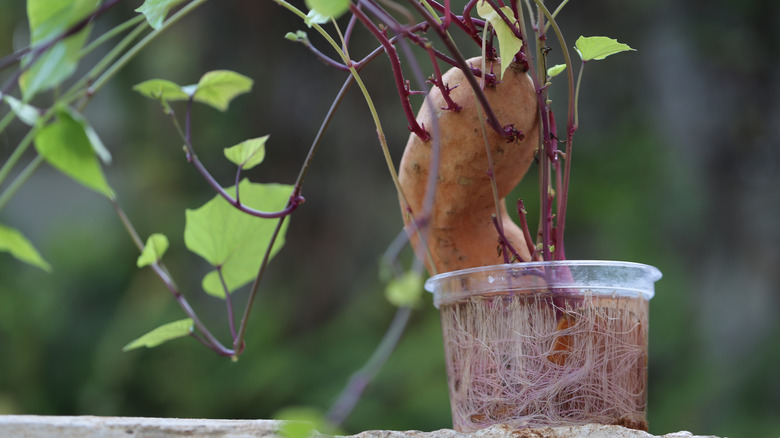February Is The Right Time To Start Sweet Potatoes. Our Master Gardener Explains Why
If you've ever tried growing sweet potatoes in your garden, you'll know they can be a bit finicky if you want a good crop. That's why sweet potatoes are one of the most difficult vegetables to grow in your garden because you do need to have a fairly long period of warm weather and a soil temperature above 60 degrees Fahrenheit. These plants are particularly sensitive to both frost and drought. Tiffany Selvey, House Digest's Garden Editor and in-house Master Gardener, spoke exclusively to House Digest to explain why February is the right time to start sweet potatoes. "Usually sweet potato slips are available to buy in late spring since sweet potatoes need hot weather and warm soil to grow and thrive," she says. "Slips are rooted stems that you can grow yourself starting in February."
It does take a while to produce those slips ready for planting, so getting the timing right is a crucial step that you don't want to overlook. Essentially, starting your slips as early as possible will give you the highest chance of reaping a successful harvest. "You can start a little earlier or later, but for most regions that have long enough summers to grow sweet potatoes, February is the ideal time," Selvey goes on to explain further. "Starting this early in the season gives you plenty of time to grow the slips and root them so they're ready when the soil is warm."
How to start your sweet potatoes in February
Starting your own sweet potato slips indoors while it's still cold and bleak outside is actually quite simple. Speaking exclusively to House Digest, Selvey explains how to start your slips in water the easy way. "The first step is selecting a few healthy, organic sweet potatoes from the store," she says. "Organic is ideal because they're less likely to have been sprayed with something to keep them from sprouting. Place the whole potato with the pointy end up. You can secure your potatoes, keeping them about half submerged in water, by inserting toothpicks around the perimeter."
After a few weeks, you should see some sprouts start to emerge from the eyes in the tuber. You'll find that these will grow relatively quickly, so make sure to keep an eye on them and then take the next step. "When the sprouts are at least 4 inches tall, carefully pluck them off," Selvey explains. "These are the slips. Place those in fresh water where they will grow roots. By the time warm days come along, you'll have fully rooted sweet potato slips ready to plant." These can then be planted straight into your garden or into grow bags. In fact, if you have limited space in your garden, it's not that difficult to grow sweet potatoes in containers like a pro.
Patience is the key to growing sweet potatoes
If you decide to try growing your own potato slips, you will have to be patient. As Selvey says in her exclusive chat with House Digest, "Growing sweet potatoes from potato to harvest is a very long process. Although it's not labor-intensive, it does require patience since it takes a few months to get slips that are ready to plant — much longer than it takes to buy them!" Don't forget that you'll have to keep them in a well-lit spot, such as a bright window sill, where they can get indirect sun for all that time. You might have to top up the water and even refresh it during this time as well, to keep the roots healthy.
Typically, it will take around three months before you'll have fully-rooted slips that you can plant in the yard. This means that if you start them as early as February, you should have well-grown plants you can then pop into your garden around May after the soil has had a chance to warm up. As a side note, you might also find it interesting that the sweet potato makes a stunning indoor vining plant that's much easier to care for than your dramatic pothos. So if you have some spare slips, why not give this a try?

